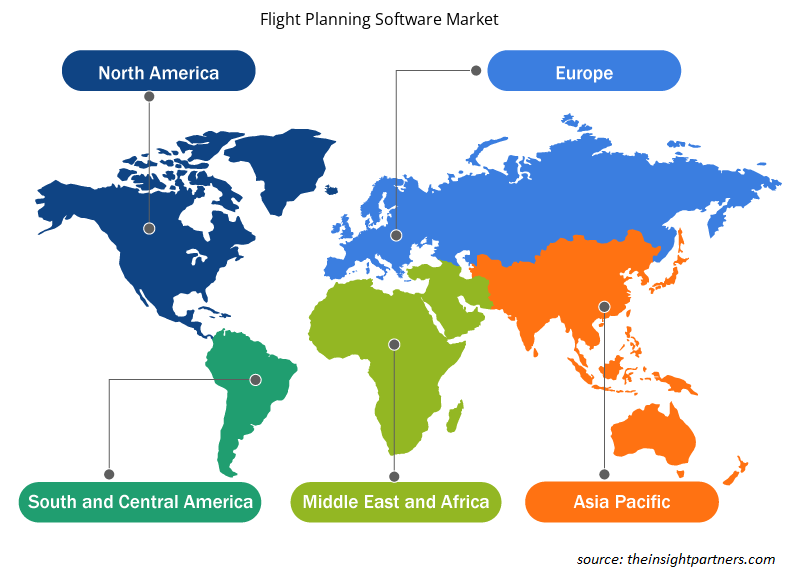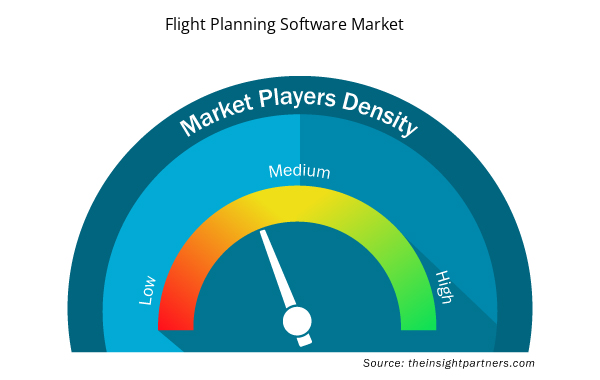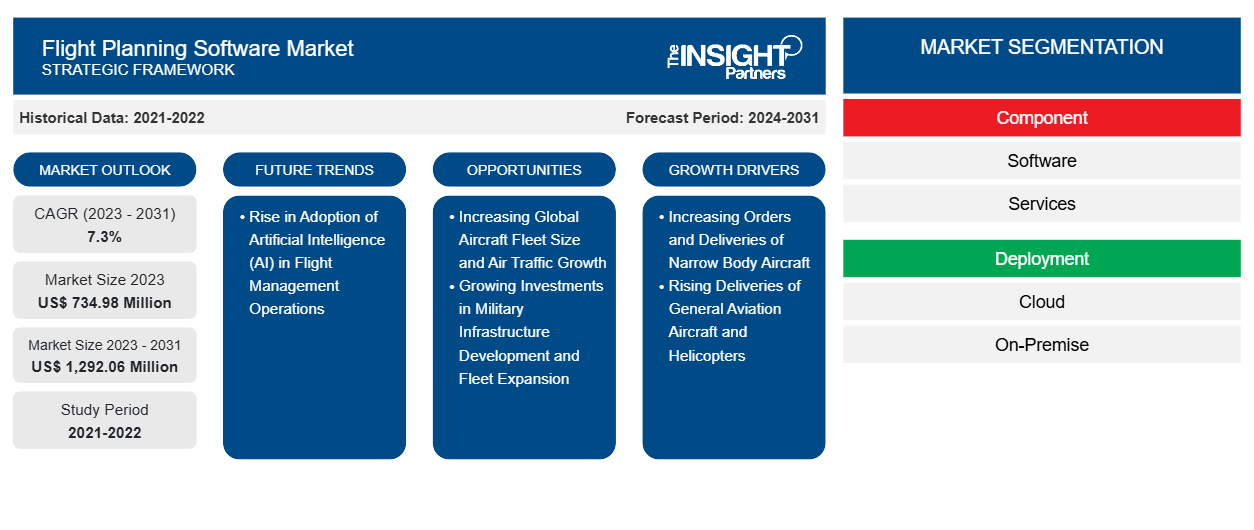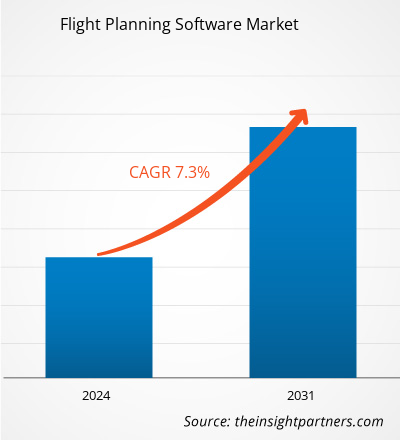预计到 2031 年,飞行计划软件市场规模将从 2023 年的 7.3498 亿美元增至 12.9206 亿美元。预计 2023-2031 年期间市场复合年增长率将达到 7.3%。飞行管理运营中人工智能 (AI) 的采用率上升可能会成为市场趋势。
飞行计划软件市场分析
推动飞行计划软件市场增长的关键因素包括窄体飞机、通用航空飞机和直升机的订单和交付量增加。然而,与飞行管理数据相关的挑战阻碍了飞行计划软件市场的增长。此外,预计在预测期内,全球飞机机队规模和空中交通量的增加以及对军事基础设施开发和机队扩张的投资增加将为飞行计划软件市场的主要参与者创造机会。此外,预计从 2023 年到 2031 年,人工智能 (AI) 在飞行管理运营中的采用和作用的增加将成为飞行计划软件市场的主要趋势。
飞行计划软件市场概览
飞行计划软件已成为现代航空业不可或缺的一部分,可提供航线优化、天气分析和燃油估算工具。飞行计划软件可让飞行员随时了解所有相关天气条件的变化和发展。提前了解飞机将遇到的天气情况有助于飞行员对飞机位置做出慎重的决定。该市场服务于商业航空公司、公务航空、军事行动和通用航空领域,提供从基本飞行计算器到复杂的企业级系统等各种解决方案。调度的最佳利用、准确的飞行计划、动态空中重新规划和动态航线优化是影响整体飞行运营性能的几个变量。飞行计划算法可以使用最新的气象预报来确定不太可能遇到湍流的航线。空中交通管理解决方案与航线优化相结合,以降低因飞行计划问题而产生的成本。
飞行规划软件用于航线规划和优化、机组人员调度和管理、天气跟踪和分析、飞机性能监控、航班跟踪、飞行规划和燃料使用优化。航空业更具活力,拥有 Hyperloop 等未来替代交通工具,以及先进的 AR/VR 技术的重要性。尽管航空旅行仍然是长途旅行的首选方式,但随着行业适应人工智能 (AI)、大数据、机器学习和机上连接等先进技术,这种情况可能会发生变化。公司正在开发飞行规划软件解决方案,以帮助航空公司和机场提高生产力、降低成本并改善乘客体验。
定制此报告以满足您的需求
您可以免费定制任何报告,包括本报告的部分内容、国家级分析、Excel 数据包,以及为初创企业和大学提供优惠和折扣
- 获取此报告的关键市场趋势。这个免费样品将包括数据分析,从市场趋势到估计和预测。
飞行计划软件市场驱动因素和机遇
窄体飞机订单和交付量增加
多年来,航空业发展迅速,飞机生产和交付数量显著增加。这表明全球各商用飞机制造商的订单量巨大。随着航空旅行乘客和飞机数量的增加,预计未来几年商用航空业将激增。全球窄体客机和商用飞机订单的增加推动了对飞行计划软件的需求。因此,航空公司计划通过开通飞往较小城市机场的航线,将业务扩展到更偏远的地区。随着飞机和机场数量的增加,对飞行计划软件的需求也在增加。
全球飞机机队规模和空中交通量增长
根据空客 GMF 2024 对全球飞机机队和交通量的研究,航空机队预计将从 2023 年的 24,260 架增至 2043 年的 48,230 架。这是由于航空旅行需求持续增长,以及新冠疫情旅行限制以来的快速复苏。根据 Avolon 的研究,预计从 2023 年到 2042 年,中国、印度、亚洲和南美洲的航空旅行量将增长 3.5% 以上;然而,北美和欧洲在此期间将实现 2% 至 3% 的温和增长。此外,上述地区飞机机队数量的大幅增加预计将为全球主要飞行计划软件制造商创造机会。
根据空客 GMF 的数据,2024 年至 2043 年期间对新飞机的需求价值为 42,430 架。预计亚太地区将占研究期间新飞机总需求的 45.98%,其次是欧洲和独联体以及北美。预计单通道飞机将占 2024 年至 2043 年期间全球新飞机总需求的 80% 以上。此外,预计 2024 年至 2043 年期间对货运飞机的需求价值为 2,470 架。
飞行计划软件市场报告细分分析
有助于得出飞行计划软件市场分析的关键部分是组件、部署和应用。
- 根据组件,全球飞行计划软件市场分为软件和服务。软件部分在 2023 年占据了更大的市场份额。
- 根据部署方式,市场分为云和本地部署。2023 年,云部署将占据更大的市场份额。
- 根据应用,市场分为物流和货运、机场、私人航空公司、商业航空公司、飞行学校和培训中心以及军事和国防。商业航空公司部门在 2023 年占据了最大的市场份额。
飞行计划软件市场份额(按地区)分析
飞行计划软件市场报告的地理范围主要分为五个地区:北美、亚太、欧洲、中东和非洲、南美。
2023 年,亚太地区占据飞行计划软件市场的主导地位,份额为 32.1%;预测期内,亚太地区很可能继续保持主导地位,到 2031 年将占据 35.1% 的份额。北美是飞行计划软件市场的第二大贡献者,其次是欧洲。由于主要参与者专注于飞行计划软件的进步并支持其在飞行管理运营中的应用,北美市场正在见证巨大的增长。根据美国航空公司在 2023 年发布的数据,商业航空占美国 GDP 的 5%,即 2023 年的 1.37 万亿美元。此外,航空客运量的增加以及政府增加国防和商业航空领域飞机机队的举措预计将在预测期内推动对飞行管理解决方案(如飞行计划软件)的需求。
在亚太地区,市场增长主要归因于该地区飞机机队的扩张和机场基础设施的发展。国际航空运输协会预测,到 2036 年,可能会有 21 亿旅客出行,尤其是在中国。乘客数量的增加预计将推动对航班管理软件和服务的需求。这一因素预计将在预测期内为航班规划软件市场的主要参与者创造机会。
欧洲的飞行计划软件市场分为德国、意大利、俄罗斯、法国、英国和欧洲其他地区。欧洲每天有超过 20,000 个航班,每年有约 5 亿乘客,被认为是世界上最繁忙的空域。此外,欧洲的国防和商业航空部门倾向于使用飞行计划软件等先进的飞行管理技术。由于经济状况强劲以及欧洲各国政府的有利举措,这些行业正在扩大。
飞行计划软件市场区域洞察
Insight Partners 的分析师已详细解释了预测期内影响飞行规划软件市场的区域趋势和因素。本节还讨论了北美、欧洲、亚太地区、中东和非洲以及南美和中美洲的飞行规划软件市场细分和地理位置。

- 获取飞行计划软件市场的区域特定数据
飞行计划软件市场报告范围
| 报告属性 | 细节 |
|---|---|
| 2023 年的市场规模 | 7.3498亿美元 |
| 2031 年市场规模 | 12.9206亿美元 |
| 全球复合年增长率(2023 - 2031) | 7.3% |
| 史料 | 2021-2022 |
| 预测期 | 2024-2031 |
| 涵盖的领域 | 按组件
|
| 覆盖地区和国家 | 北美
|
| 市场领导者和主要公司简介 |
|
飞行计划软件市场参与者密度:了解其对业务动态的影响
飞行计划软件市场正在快速增长,这得益于最终用户需求的不断增长,这些需求源于消费者偏好的不断变化、技术进步以及对产品优势的认识不断提高等因素。随着需求的增加,企业正在扩大其产品范围,进行创新以满足消费者需求,并利用新兴趋势,从而进一步推动市场增长。
市场参与者密度是指在特定市场或行业内运营的企业或公司的分布情况。它表明相对于给定市场空间的规模或总市场价值,有多少竞争对手(市场参与者)存在于该市场空间中。
在飞行计划软件市场运营的主要公司有:
- 艾玛迪斯信息技术集团
- 柯林斯航空航天
- CAE公司
- NAV 飞行服务
- 杰普森
- Sabre GLBL 公司
免责声明:上面列出的公司没有按照任何特定顺序排列。

- 获取飞行计划软件市场顶级关键参与者概览
飞行计划软件市场新闻和最新发展
飞行计划软件市场通过收集一手和二手研究后的定性和定量数据进行评估,其中包括重要的公司出版物、协会数据和数据库。飞行计划软件市场的一些发展如下:
- AIR SUPPORT 宣布,Sunlight Air 已选择 PPS 飞行规划软件来优化其飞行运营。(来源:AIR SUPPORT,新闻稿,2024 年)
- 领先的创新航空软件解决方案提供商 eTT Aviation 宣布 Sterling Airways 运营的阿留申航空成为其最新客户。(来源:eTT Aviation,新闻稿,2024 年)
- ForeFlight LLC 推出了 Voyager,这是一款专为 Apple Vision Pro 设计的创新免费应用程序。(来源:ForeFlight LLC,新闻稿,2024 年)
飞行计划软件市场报告范围和交付成果
“飞行计划软件市场规模和预测(2021-2031)”报告对以下领域进行了详细的市场分析:
- 飞行计划软件市场规模及全球、区域和国家层面所有主要细分市场的预测
- 飞行计划软件市场趋势,以及驱动因素、限制因素和关键机遇等市场动态
- 详细的波特和 SWOT 分析
- 飞行计划软件市场分析涵盖主要市场趋势、全球和区域框架、主要参与者、法规和最新市场发展
- 行业格局和竞争分析,涵盖市场集中度、热图分析、知名参与者以及飞行计划软件市场的最新发展
- 详细的公司简介
- 历史分析(2 年)、基准年、预测(7 年)及复合年增长率
- PEST 和 SWOT 分析
- 市场规模价值/数量 - 全球、区域、国家
- 行业和竞争格局
- Excel 数据集



Report Coverage
Revenue forecast, Company Analysis, Industry landscape, Growth factors, and Trends

Segment Covered
This text is related
to segments covered.

Regional Scope
North America, Europe, Asia Pacific, Middle East & Africa, South & Central America

Country Scope
This text is related
to country scope.
常见问题
The flight planning software marketis expected to reach US$ 1292.06 million by 2031.
The key players holding majority shares in the flight planning software market are Collins Aerospace, The Boeing Co, Honeywell International Inc, Amadeus IT Group, and Sabre.
Increasing orders and deliveries of narrow body aircraft, and rising deliveries of general aviation aircraft and helicopters are the major factors that propel the flight planning software market.
The incremental growth expected to be recorded for the flight planning software market during the forecast period is US$ 557.08 million.
The flight planning software market was estimated to be US$ 734.98 million in 2023 and is expected to grow at a CAGR of 7.3 % during the forecast period 2023 – 2031.
Rise in adoption of artificial intelligence (AI) in flight management operations is anticipated to play a significant role in the flight planning software market in the coming years.
Trends and growth analysis reports related to Technology, Media and Telecommunications : READ MORE..
The List of Companies - Flight Planning Software Market
- Amadeus IT Group SA
- Collins Aerospace
- CAE Inc
- NAV Flight Services
- Jeppesen
- Sabre GLBL Inc
- AIR SUPPORT A/S
- FSS Flight Planning
- Navblue
- Laminaar Aviation Infotech Pvt Ltd.
- Universal Weather and Aviation, Inc.
- Lufthansa Systems
- ForeFlight
- Chetu Inc
- eTT Aviation
- GE Aerospace
- IBS Software
The Insight Partners performs research in 4 major stages: Data Collection & Secondary Research, Primary Research, Data Analysis and Data Triangulation & Final Review.
- Data Collection and Secondary Research:
As a market research and consulting firm operating from a decade, we have published and advised several client across the globe. First step for any study will start with an assessment of currently available data and insights from existing reports. Further, historical and current market information is collected from Investor Presentations, Annual Reports, SEC Filings, etc., and other information related to company’s performance and market positioning are gathered from Paid Databases (Factiva, Hoovers, and Reuters) and various other publications available in public domain.
Several associations trade associates, technical forums, institutes, societies and organization are accessed to gain technical as well as market related insights through their publications such as research papers, blogs and press releases related to the studies are referred to get cues about the market. Further, white papers, journals, magazines, and other news articles published in last 3 years are scrutinized and analyzed to understand the current market trends.
- Primary Research:
The primarily interview analysis comprise of data obtained from industry participants interview and answers to survey questions gathered by in-house primary team.
For primary research, interviews are conducted with industry experts/CEOs/Marketing Managers/VPs/Subject Matter Experts from both demand and supply side to get a 360-degree view of the market. The primary team conducts several interviews based on the complexity of the markets to understand the various market trends and dynamics which makes research more credible and precise.
A typical research interview fulfils the following functions:
- Provides first-hand information on the market size, market trends, growth trends, competitive landscape, and outlook
- Validates and strengthens in-house secondary research findings
- Develops the analysis team’s expertise and market understanding
Primary research involves email interactions and telephone interviews for each market, category, segment, and sub-segment across geographies. The participants who typically take part in such a process include, but are not limited to:
- Industry participants: VPs, business development managers, market intelligence managers and national sales managers
- Outside experts: Valuation experts, research analysts and key opinion leaders specializing in the electronics and semiconductor industry.
Below is the breakup of our primary respondents by company, designation, and region:

Once we receive the confirmation from primary research sources or primary respondents, we finalize the base year market estimation and forecast the data as per the macroeconomic and microeconomic factors assessed during data collection.
- Data Analysis:
Once data is validated through both secondary as well as primary respondents, we finalize the market estimations by hypothesis formulation and factor analysis at regional and country level.
- Macro-Economic Factor Analysis:
We analyse macroeconomic indicators such the gross domestic product (GDP), increase in the demand for goods and services across industries, technological advancement, regional economic growth, governmental policies, the influence of COVID-19, PEST analysis, and other aspects. This analysis aids in setting benchmarks for various nations/regions and approximating market splits. Additionally, the general trend of the aforementioned components aid in determining the market's development possibilities.
- Country Level Data:
Various factors that are especially aligned to the country are taken into account to determine the market size for a certain area and country, including the presence of vendors, such as headquarters and offices, the country's GDP, demand patterns, and industry growth. To comprehend the market dynamics for the nation, a number of growth variables, inhibitors, application areas, and current market trends are researched. The aforementioned elements aid in determining the country's overall market's growth potential.
- Company Profile:
The “Table of Contents” is formulated by listing and analyzing more than 25 - 30 companies operating in the market ecosystem across geographies. However, we profile only 10 companies as a standard practice in our syndicate reports. These 10 companies comprise leading, emerging, and regional players. Nonetheless, our analysis is not restricted to the 10 listed companies, we also analyze other companies present in the market to develop a holistic view and understand the prevailing trends. The “Company Profiles” section in the report covers key facts, business description, products & services, financial information, SWOT analysis, and key developments. The financial information presented is extracted from the annual reports and official documents of the publicly listed companies. Upon collecting the information for the sections of respective companies, we verify them via various primary sources and then compile the data in respective company profiles. The company level information helps us in deriving the base number as well as in forecasting the market size.
- Developing Base Number:
Aggregation of sales statistics (2020-2022) and macro-economic factor, and other secondary and primary research insights are utilized to arrive at base number and related market shares for 2022. The data gaps are identified in this step and relevant market data is analyzed, collected from paid primary interviews or databases. On finalizing the base year market size, forecasts are developed on the basis of macro-economic, industry and market growth factors and company level analysis.
- Data Triangulation and Final Review:
The market findings and base year market size calculations are validated from supply as well as demand side. Demand side validations are based on macro-economic factor analysis and benchmarks for respective regions and countries. In case of supply side validations, revenues of major companies are estimated (in case not available) based on industry benchmark, approximate number of employees, product portfolio, and primary interviews revenues are gathered. Further revenue from target product/service segment is assessed to avoid overshooting of market statistics. In case of heavy deviations between supply and demand side values, all thes steps are repeated to achieve synchronization.
We follow an iterative model, wherein we share our research findings with Subject Matter Experts (SME’s) and Key Opinion Leaders (KOLs) until consensus view of the market is not formulated – this model negates any drastic deviation in the opinions of experts. Only validated and universally acceptable research findings are quoted in our reports.
We have important check points that we use to validate our research findings – which we call – data triangulation, where we validate the information, we generate from secondary sources with primary interviews and then we re-validate with our internal data bases and Subject matter experts. This comprehensive model enables us to deliver high quality, reliable data in shortest possible time.


 获取此报告的免费样本
获取此报告的免费样本